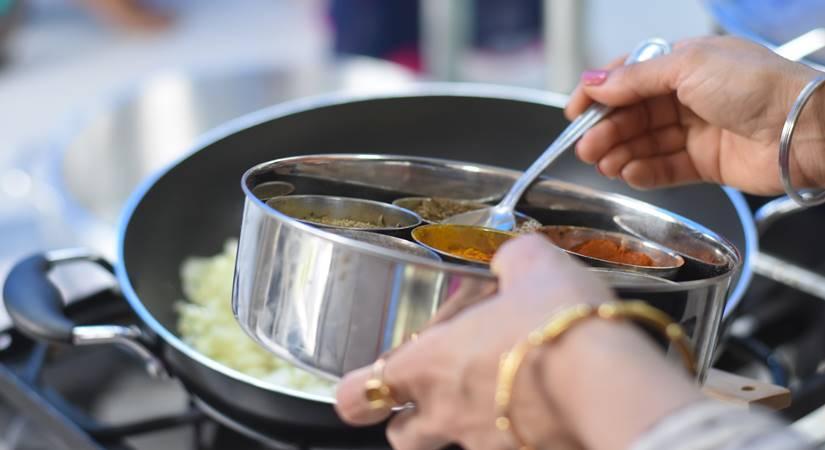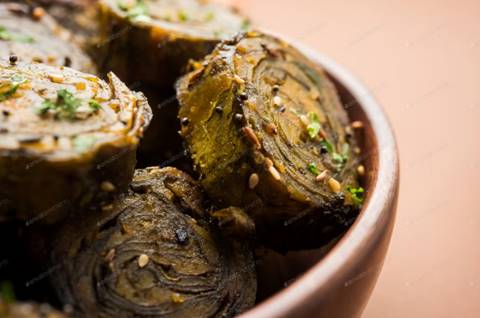Cover Story
You are what you eat

Try these local delicacies
ByLuke Coutinho
April 1, 2022 (IANSlife) Luke Coutinho, Co-founder of You Care Lifestyle shares some healthy recipes for Gudi Padwa.
Puran Poli

Puran Poli is a flat roti stuffed with sweet lentil filling made from split Bengal gram/chana dal and organic jaggery. In Marathi, this sweet filling is called puran and the roti is called poli.
Ingredients:
For Puran:
- 1 cup organic jaggery (250ml) - 1 cup chana dal (skinned split Bengal gram soaked for 12 14 hours with water being changed every 6-7 hours) -3 cups water to pressure cook the chana Dal -2 tsp ghee (A2 organic ghee)
- 1 tsp cardamom powder
- 1 tsp fennel powder - 1/4 tsp nutmeg powder
For the Poli(roti):
- 1.5 cups organic khapali wheat 4 tbsp ghee (A2 organic ghee)
- 1/2 tsp pink salt
- 1/4 tsp organic turmeric
- Water as required to knead the dough.
Method to make the Puran:
- Rinse the soaked chana dal, in a pressure cooker
Preparing the poli(roti):
- Take a medium-sized ball from the dough prepared to roll it to 3 inches in circumference on the rolling board.
- Place the Puran mixture in the center.
- Bring the edges together and join all the edges. 4. Sprinkle some flour and start rolling the dough till a medium-size poli is made.
- On a heated griddle, spread some ghee and place the poli.
- When the inner side gets brown flip it over and apply ghee.
- If everything is done well the Puran poli will puff and brown spots will appear.
- Serve hot with a topping off ghee on top.
Notes: Soaking of chana dal for 12- 14 hours releases the phytic acid and they become more easily digestible.
- Soaking helps in faster cooking of the chana daltoo and hence making it softer and easily digestible.
- Cardamom resolves digestive issues.
- Nutmeg boosts immunity and fennel powder hasanti-inflammatory properties.
- Organic jaggery is loaded with antioxidants andminerals.
- Puran Poli is loaded with iron, calcium and is acereal pulse combination which makes it acomplete protein.
- Khapali wheat is rich in complex carbs, fiber, trace minerals, and amino acids.
Alu Vadi

Pelting Mumbai rains call for the most comforting tea-time snack -Alu Vadi is a perfect tea-time match.
Equipment
- Steamer
- Sharp knife
Ingredients
- 6 large fresh colocasia leaves arvi/arbi/taro leaves
- 200 g chickpea flour besan
- 50 g rice flour
- 50 g sattu flour
- 2 tsp ground cinna
- 1 tsp immunity powder
- 2 tsp ground Ceylon/Srilankan cinnamon
- 1/4 tsp Ajwain
- 1 tsp ground fennel seeds
- 1 tsp chili powder
- 1/2 tsp ground cumin seeds
- 1 1/2 tsp salt
- 1 inch ginger peeled and grated
- 2 green chillies optional
- 5 tbsp fresh tamarind pulp
- 100 g jaggery powder
- 500 ml water
For the tempering
For the tadka:
- 1 tbsp cold pressed coconut oil or unrefined mustard oil
- 1 tbsp mustard seeds
- 1 tsp asafoetida
- 2 tbsp sesame seeds
- 10-12 curry leaves
- 2 tbsp fresh coriander leaves to garnish.
Instructions:
To prepare the colocasia leaves:
- Begin by wiping the colocasia leaves.
- Clean with a damp kitchen towel.
- Clean both sides thoroughly.
- Use a sharp knife to laterally trim the thick spine that runs down the leaf.
- Simply run the knife across the stalk to flatten it so it feels flat to the touch.
- Continue this process for all of the veins that branch out from the centre.
- Repeat the trimming for all the leaves.
To make the batter:
- In a large bowl, combine the chickpea flour, rice flour,sattu flour, ground cinnamon, immunity powder, ajwain,ground fennel seeds, ground cumin seeds, chilli powder, and salt.
- Whisk to combine.
- Add the grated ginger, green chilli paste, tamarind and jaggery powder.
- Slowly add the water, whisking all the time to ensure a smooth paste is formed without lumps.
- Continue whisking for 5 minutes until the paste is smooth.
- Set aside for 15 minutes.
To assemble the Alu Vadi-
- Organise the colocasia leaves by size.
- The assembly process will begin with the largest leaves to the smallest leaf.
- Take the largest colocasia leaf and lay it (dull side up) out on a clean, flat surface.
- Top with a large spoonful of batter.
- Use a rubber spatula, or your hands to spread the batter over the leaf.
- Take the second largest leaf and place it dull side-up in the opposite direction to the first leaf.
- It should look like a butterfly, the four corners resembling wings.
- Repeat the spreading process so that the second leaf is covered and place the next leaf in the opposite direction once again.
- Once all the five leaves are stacked, cover it finally with more batter.
- Fold one side of the leaves down to the center.
- Repeat for the other side so the leaves meet in the middle.
- It should form a rectangle.
- Cover with more batter.
- Starting from the short side, begin to form a tight roll.
- Ensure the roll is as tight as it can be without the batter squeezing out or the leaves breaking.
- Rub any remaining batter on the outside of the log to stick down any loose ends.
To steam the Alu Vadi:
- Heat up water and place the pot in a cooker.
- Grease a dish with a few drops of oil and place it in the pot.
- Place the rolls on the dish with the sealed side facing down.
- Close the lid and steam on medium heat for 15 minutes.
- Let it cool down and cut the roll into ½ in wide pieces.
To finish the Alu Vadi:
- Slice the cooled Alu Vadi into 1/2cm pieces using a sharp knife.
- If you prefer a lighter snack, you can eat them steamed too.
For the tampering:
- Heat the oil in a pan.
- Add the mustard seeds once they crackle, add asafoetida, sesame seeds and curry leaves.
- Arrange the Alu vadi slices in the pan and cook on both sides until golden brown and crispy all over.
- Remove from the pan and garnish with fresh coriander leaves.
- Serve warm or at room temperature with masala chai.
Important Note:
- Do not consume taro leaves as a raw vegetable or in their raw state.
- They should be soaked first in clean water and then cooked for at least 30 minutes.
(Recipes by Luke Coutinho, Co-founder of You Care Lifestyle)
(This article is website exclusive and cannot be reproduced without the permission of IANSlife)
IANSlife can be contacted at ianslife@ians.in


